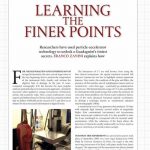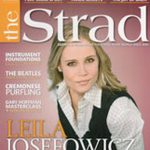The Strad magazine, May 2013 issue: Bartolomeo Cristofori: performer, inventor, luthier
Copyright © 2013 Alberto Giordano – The Strad magazine. All rights reserved
A 1705 violin by renowned keyboard innovator Bartolomeo Cristofori has recently come to light. Alberto Giordano assesses both the instrument and the piano maker’s legacy to the string world
For centuries, Bartolomeo Cristofori has been acknowledged as the inventor of the piano. While working at the court of the Grand Prince of Tuscany, Ferdinando de’ Medici, he worked on a number of keyboard instruments before developing the first pianoforte around 1700. His role as a maker of stringed instruments, however, has long been in dispute: despite working at the court for most of his career, no inventory of the Medicis’ collection ever included a violin, cello or double bass made by Cristofori. Only a very few stringed instruments attributed to him have survived, though they bear many stylistic similarities – and until very recently, our knowledge of his work was limited to just a few cellos and two double basses. Now, though, a violin has come to light bearing not only an autograph label but also many of the hallmarks of Cristofori’s work. Having been carefully preserved in a private collection for the past two centuries, it may give us a greater understanding of the maker’s influences and working methods.
Despite Cristofori’s significance in musical history, details of his own life remain as scarce as his stringed instruments. It is certain that he was born in Padua, northern Italy, on 4 May 1655 but nothing is known about his apprenticeship, though the city had a fair amount of musical activity: a number of good lute makers worked there, including Michael Harton and Giovanni Railich, the teacher of Matthias Klotz. A version of Cristofori’s name appears in the 1680 Cremona census as part of Nicolò Amati’s household (a fact uncovered during research for the Hill brothers’ work on the Guarneri family). One ‘Christofaro Bartolomei’, 13 years of age, appears as an ‘individual’: a young apprentice living in the Amati house. On this evidence it was long believed that Cristofori was a direct pupil of the 84-year-old Nicolò Amati, and that he was a violin maker before dedicating himself to piano making. This theory has been contested, though, because in 1680 Cristofori was a young man of 27 – and according to the law of that time, he would have been too old to be residing in the Amati household. Even more obviously, his first name and surname are written the wrong way round, suggesting that Bartolomei was indeed a different man (although Cristoforo and Bartolomeo are both Italian Christian names).
Whatever the circumstances of his apprenticeship, by 1688 Cristofori had achieved renown in the keyboard field, as both a player and a maker – so much so that Ferdinando de’ Medici convinced him to join the Gallery of Works, a haven for the most talented artisans of the day, based at the Uffizi Palace in Florence. Possibly the Grand Prince had heard talk of this gifted maker during one of his many excursions to Venice, where he was a frequent visitor to the annual carnival. At any rate, when Cristofori signed his agreement to work for Ferdinando, he was given an annual stipend of twelve scudi per month, a considerable wage for those times. Around a hundred craftsmen might be working in the Gallery at one time, and Cristofori himself remarked that it was hard to work in there with all that noise.
His duties in the workshops were quite flexible: he took care of maintenance and restoration of the ancient instruments in the Medici collection; he was in charge of the transformation of some of them; and above all, he was encouraged to invent and create new keyboard instruments. In addition, he was appointed by the Grand Prince to his so-called Virtuosi da Camera, a privilege accorded to only a select group of virtuoso musicians. This honour indicates that his activity as a player was highly appreciated and he was also very busy in the court’s musical life. After the death of the Grand Prince in 1713, however, interest in music at the court decreased significantly. Cristofori remained in Florence as a conservator: he continued his making activities and in 1716 he compiled a complete inventory of the collection. He died on 27 January 1732 at the age of 76.
With Cristofori occupying such a high position at Ferdinando’s court, why is it that none of his stringed instruments ever appeared in an inventory, and no documentation referring to them has ever come to light? It must be considered that, being directly employed by the Grand Prince (and after his death, by the court itself), Cristofori had the privilege of managing his business with a good degree of independence, without being held to the rules of most instrument makers. Moreover, the musical instrument trade in Florence was fairly flexible, owing to a complicated system that divided craftsmen according to the tools and materials they used. As there was no guild of instrument makers, they were usually classed as woodworkers but could also be put in the same bracket as armourers, or even olive oil retailers. This situation probably allowed instrument makers a certain freedom in their trade: it could also explain why luthiers such as Giovanni Battista Gabrielli and Cristofori’s own pupil, Giovanni Ferrini, sold their tools well before they were registered with their respective peers.
In the cellos and basses we know of that bear an original ‘Bartolomeo Cristofori’ label, there are some similarities regarding materials and basic making features. All the instruments are dated between 1715 and 1717: the oldest in this group is a large double bass now in the Conservatorio Luigi Cherubini collection at Florence’s Galleria dell’Accademia. Cristofori’s autograph is clearly written in ink on the inside of the back plate: ‘Bartolomeo Cristofori in Firenze 1715 Primo.’ The bass has only been recorded in the Galleria’s inventory since 1819. It was modified in 1901 by Valentino de Zorzi, who added a fifth string. The design and the carving of its scroll are convincing, though it is still not known whether Cristofori signed his name but left the greater part of the job to his workers.
A cello dated 1716 shows some characteristics that suggest a more individual style of work. In spite of its large proportions, the cello (given a full appraisal by John Dilworth in the January 1985 issue of The Strad) reveals an elegant design and a Cremonese inspiration. Though the maker seems unaware of Stradivari’s innovation in reducing the size of cellos, this instrument has been fashioned with skill and confidence. Its scroll reportedly bears a number of interesting features that resemble the work of Gabrielli – considered the founder of the Florentine school of making.
The stylistic features so far noted have numerous parallels in the violin presented here. Now the property of the Chi Mei Culture Foundation, this is the first Cristofori violin ever discovered: the autograph label inside the soundbox reads, ‘Bartholomeus de Cristoforis Florentiae 1705’ and it is interesting to observe that the writing recalls the wording of the labels used by Cristofori on some of his keyboard instruments. The Christian name is written in Latin (in this case with an ‘e’ rather than ‘ae’), the surname is ennobled by the add of ‘de’ (of), and the name of the city is correctly given the Latin genitive. Written with an ink that now appears a delicate brownish–red, the paper has remained in place undisturbed: the date of 1705 indicates that Cristofori was active as a violin maker a full ten years before the previously mentioned instruments. Dendrochronology has confirmed the age of the pine used for the belly, placing the youngest ring of the tree in the year 1692. The year and the physical features of this wood are very close to the pine of an unlabelled cello, attributed to Cristofori by the Hill brothers in 1936, which is also now in the care of the Chi Mei Culture Foundation.
Unlike the cellos and double basses, this violin is freely inspired by the work of Jacob Stainer. Two violins of the German maker were listed in the Grand Prince’s collection in 1700, evidence of the esteem in which contemporary musicians held his instruments, particularly in the Florentine court.
Considering that the instrument has suffered a single bad accident in its lifetime (resulting in a significant crack on the back under the button, and a few cracks on the side and front), it is in a good state of preservation. Its 18th-century pegs still fit the head, and a tiny jujube button, probably original, holds the tail gut in place. In spite of some small cracks, the violin has survived three centuries without suffering any major alteration: the neck is original and it was reset by adding a ‘shoe’ at the neck root, and then reset in the soundbox by mortising the upper block. The oxidation of the nails that stained the grain of the maple can still be seen on the neck heel.
Looking inside the soundbox, the linings and blocks were made on an internal mould. Both blocks and linings are made of willow, the linings mortised in the corner-blocks and in the lower block, and thinned with a small gouge, using quite a fast gesture. The lower block was left rough with fast cuts of a chisel, and the top-block was substituted during a repair in 1867 by Neapolitan violin maker Vincenzo Postiglione.
The plates are considerably high: the belly 19.5mm and the back 19mm. The arching of the belly is quite straight and long when viewed in profile. From the front, it looks full in the centre and then descends gently to the borders, which are kept quite flat. It’s interesting to see that the inner rounding of the borders was not filed. Instead, it was cut with a knife or chisel, and it shows a flat line before the joint with the ribs. The overhang is quite irregular: the thickness of the border is around 3mm.
The purflings are made of maple, with a consistent 1.5mm thickness. The ‘white’ is predominant and both are set 3.3mm from the border. Corner joints have no extensions and there is some chipping along the run of the purfling, as well as a few knife marks. The scoop is lightly cut, finished with a scraper and gently rounded. The f-holes, placed with the upper eyes widely spaced, are cut with great confidence, the lower palettes left unfluted: the contour is barely rounded and the nicks have been made with sure cuts.
The design of the scroll looks elegant and well balanced, and the chamfer perfectly defines the scroll’s profile line. The chamfer is smartly rounded and enhances the cut of the turns, in which gouge marks are visible. From the front, the pegbox has a strongly tapered design with the flanks well rounded: no centre line or dot mark is visible, and the scoop in the front and rear view was cut quite hollow.
The varnish is of a light orange colour, not very thick and a little hard in the texture with a good transparency. The pale grey–yellow ground enhances the flames, which appear to remain quite still.
The stylistic features of this violin are a testimony to its Florentine provenance. The model used recalls the later interpretations of Gabrielli, as do the cutting and rounding of the scroll, the use of a particular ground, and the slight opaque effect of the varnish. In this sense, the instrument proposes itself as a reference violin in the violin making tradition of Florence and it marks a further step in the assessment of Bartolomeo Cristofori’s legacy as an accomplished, although sporadic, stringed instrument maker.
The court of the Medici
At the start of the 18th century, both Alessandro Scarlatti and George Frideric Handel were living and working in Florence, a city in the midst of a musical revolution. From the late Renaissance up to the Baroque period, the city was renowned for masked balls, horse shows and spectacular musical entertainment requiring advanced theatrical machinery. This was largely down to the efforts of Ferdinando de’ Medici, Grand Prince of Tuscany (1663–1713), a man with a great love of music, science, theatre and art. He was responsible for the recruitment of teachers, musicians and artists from other towns in Italy and abroad, and the blossoming of the court’s artistic creativity.
Ferdinando was the eldest child of Cosimo III de’ Medici, a severe man of faith with a bigot’s demeanour, who supported mainly sacred music. His son displayed his love for the arts from his earliest years, as well as an irreverent personality and inquisitive intellect.
A good musician himself, able to play both stringed and keyboard instruments, Ferdinando had a passion for the theatre and for the staging of opera. It is reported that he would concern himself with every single detail of a production, from the engagement of singers and musicians to the directing of performances. The musical activity at court was traditionally addressed to the glorification of the Medicis, but it would seem that Ferdinando’s interest stemmed from a pure artistic passion: he was proud to be portrayed among the Virtuosi da Camera musicians, and in fact he was often criticised for his too-familiar relationships with artists. In 1690 the Marquise Bartolomeo Ariberti delivered a quintet of instruments by Antonio Stradivari to the court, as a gift to the Grand Prince. Writing to the Cremonese master, Ariberti attested that the musicians ‘were unanimous in expressing their great appreciation, declaring the instruments quite perfect, and, above all, exclaiming with one voice that they had never heard a violoncello with such an agreeable tone’.
Cristofori and the pianoforte
The earliest instruments we know of that Cristofori made for the Florentine court are a spinettone (‘big spinet’) suitable for use in a large, loud orchestra, and two small oval spinets (made in 1690 and 1693), remarkable for their elegant and original designs. In the late 1690s he also made a harpsichord with an unusual ebony case. It would appear that the invention of the pianoforte mechanism, for which Cristofori is now universally credited, also comes from this period.
The invention (based on the instrument’s strings being hit with hammers rather than plucked) was described in detail in 1711 by Scipione Maffei, a noted intellectual and playwright, in the Giornale de’ letterati d’Italia (Journal of the Italian literati). Maffei referred to the new keyboard as an arpicembalo (‘harp–harpsichord’) that could play ‘the piano and the forte’ (che fa il pian e il forte), in a long, illustrated article that explained its mechanism in depth.
Maffei’s article was intended as a defence of the invention, its sound and its method of playing, as by 1711 the new keyboard had singularly failed to catch on. According to the writer, Cristofori had completed only three such instruments by that time: two were sold in Florence and the third was given to Cardinal Pietro Ottoboni in Rome.





